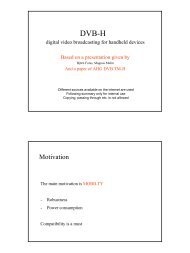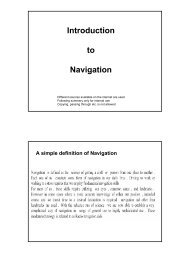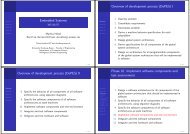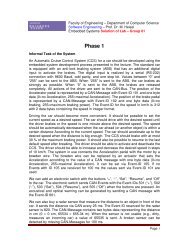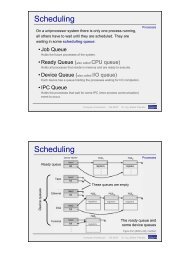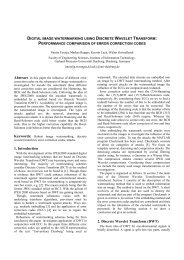Design Patterns
Design Patterns
Design Patterns
Create successful ePaper yourself
Turn your PDF publications into a flip-book with our unique Google optimized e-Paper software.
EXAMPLE<br />
Notation: UML Class Diagrams<br />
Professor Institute<br />
1 Leads 0..1<br />
name<br />
name<br />
specialty<br />
director<br />
0..2<br />
Gives<br />
*<br />
Course<br />
title<br />
4..6 Takes 3..*<br />
Student<br />
name<br />
participant inscription_number<br />
5<br />
mulitplicity reading direction<br />
7<br />
role<br />
association name<br />
OBJECT<br />
➠ Abstraction of a real thing, concept or issue.<br />
➠ Has a local state in the form of attributes.<br />
➠ Has a unique identity.<br />
➠ Has behavior defined by a set of operations.<br />
CLASS<br />
➠ Abstraction of a set of uniform objects.<br />
➠ Template for objects (instances).<br />
➠ Defines operations and attributes for its objects.<br />
➠ Corresponds to a type.<br />
DIFFERENT NOTATIONS FOR CLASSES<br />
or or<br />
Class Class Class<br />
a1: T1<br />
a2 : T2<br />
MEANING OF THE CLASS DIAGRAM<br />
6<br />
a1: T1<br />
a2 : T2<br />
➠ Each institute has exactly one professor who leads it.<br />
➠ This professor is called ”director”.<br />
➠ A professor leads at most one institute.<br />
➠ A professor can give course, but need not do so.<br />
op1(p: T1) : T2<br />
➠ Each course is given by at most two professors (also zero professors are<br />
possible).<br />
➠ A student takes four to six courses.<br />
➠ There, he is a “participant”.<br />
➠ A course has to be taken by at least three students.<br />
8



